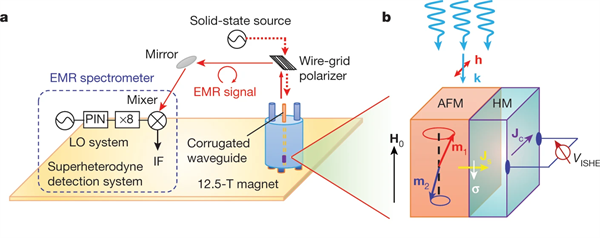Thz Radiation Detector Using Bilayers Of Antiferromagnet And Heavy Metal Films
Patent Status
| Country | Type | Number | Dated | Case |
| United States Of America | Issued Patent | 12,411,192 | 09/09/2025 | 2019-105 |
| United States Of America | Issued Patent | 11,639,975 | 05/02/2023 | 2019-105 |
Full Description
Background
Special properties of Terahertz (THz) radiation find applications in a a large and expanding range of applications. THz can penetrate many materials such as paper, plastic, textiles and foams - resulting in imaging applications such as non-destructive testing and security inspection. Because the fundamental resonances of materials are in the THz range, THz frequencies are useful for spectroscopic applications. The non-ionizing property has advanced application in biomedical imaging. Measuring radiation of a particular frequency is difficult especially for high frequencies. Current methods for THz detection are based on the volume of materials that absorb it and are therefore bulky and require expensive apparatus.
Current Invention
Prof. Jing Shi and his team at UCR have developed an innovative, patent pending THz detector that uses surface effects and therefore can be thin and compact. The invention is related to the magnetic resonance in a type of magnetic material called anti-ferromagnets. The resonance only occurs at specific frequencies that are first determined by materials and can be varied by changing the magnetic field strength of an applied field. This invention involves anti-ferromagnetic resonance and a phenomenon called spin pumping which uses a heavy metal layer (e.g., Platinum, Tantalum, etc.) to electrically detect the radiation in the frequency range of sub-THz to 10 THz.

(a) Continuous-wave (CW) EMR system (see Methods). A 0.240-THz CW is generated by a solid-state source and polarized by a wire-grid polarizer before entering the waveguide. and (b) Sample structure and spin-current injection.
Advantages
- A practical implementation that can generate and detect electromagnetic radiation in the range 0.1 to 10 Terahertz.
- Thin film device that is Anti-Ferro Magnetic (AFM) and Heavy Metal (HM) bilayer offering broad frequency tenability.
- The electrical signal does not depend on the volume of the AFM but depends on the total length of the heavy metal wires and therefore it can be greatly amplified by connecting micro-fabricated strips in series.
- Ease of implementation and compatibility with existing semiconductor IC technology.
- Cost effective.
- There are far more anti-ferromagnetic than ferromagnetic materials available in nature that offer a wide range of operating temperatures and frequencies and require different magnetic fields.
- The resonance field can be tailored by using "exchange coupling" - by depositing a ferromagnetic layer next to the AFM layer.
Suggested uses
- High resolution sensing & imaging applications in:
- Medical & Biosciences
- Security & screening systems
- Non-destructive evaluation
- Ultrafast on chip communication for 5G/6G devices
- Radio Astronomy & Cosmology
Related Materials
State Of Development
The inventors have developed an experimental, lab-level prototype. They are actively seeking collaborators to scale up and further develop the device.
User Defined 1
Please see other inventions by Prof. Jing Shi and his team at UCR.
Contact
- Venkata S. Krishnamurty
- venkata.krishnamurty@ucr.edu
- tel: View Phone Number.
